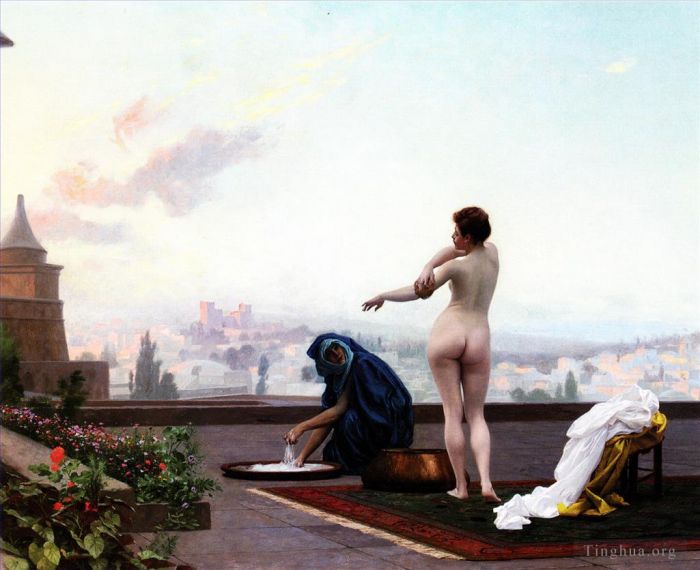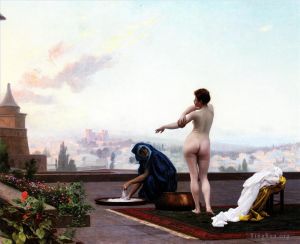Bathsheba
Jean-Leon Gerome
- Price: Price on Request
- Art Type: Oil Painting
- Size:
- English Comments: 0
- International Comments: 0
- Creating Date:
- Introduction and Works of Jean-Leon Gerome >>
Keywords:
Bathsheba
Work Overview
- BETHSABÉE
Jean-Léon Gérôme
oil on canvas
60.5 by 100cm., 23¾ by 39¼in.
According to the Hebrew Bible, Bathsheba (/bæθˈʃiːbə/ or /ˈbæθʃɪbə/;[1] Hebrew: בַּת שֶׁבַע, Baṯ-šeḇa‘, "daughter of the oath"; Arabic: بثشبع, "ابنة القسم) was the wife of Uriah the Hittite and later of David, king of the United Kingdom of Israel and Judah. She is most known for the Bible story in which she was summoned by King David who had seen her bathing and lusted after her.
She was the mother of Solomon, who succeeded David as king, making her the Queen mother.
And it came to pass in an eveningtide, that David arose from his bed, and walked upon the roof of the king's house, and from the roof he saw a woman washing herself; and the woman was very beautiful to look upon' (II Samuel 11:2)
These evocative opening lines of the Old Testament story of David and Bathsheba have found expression in Western Art through the centuries. Blending the Biblical subject with a masterful exploration of light and the human form, Gérôme's interpretation of the story belongs to his most important works.
Compelling though the story is, Gérôme's interest lay not only in its dramatic narrative. Rather, it provided the perfect pretext for exploring the female form in natural light outside of the studio. The figure of Bathsheba, 'a marvel of plastic grace and delicate flesh-tints' (Hering, p. 274), is in essence like a bather from Gérôme's numerous interior bath scenes (fig. 1) transposed into plein air. The topography in the painting is left deliberately vague, the city of Jerusalem depicted as an imaginary, generic middle-eastern skyline. The real focus of the painting is the figure's contrapposto pose, the effect of the light on her delicate white skin, and the minutely observed fabrics draped over the stool and worn by Bathsheba's attendant. Bethsabée was in fact painted at Bougival in 1889 where Gérôme worked 'on the roof of his summer atelier, enabling him to pose his model in the open air and obtain wonderful atmospheric effects' (op cit).
Bathsheba was the wife of the Hittite Uriah, who served under Joab in King David's army. Uriah is away fighting a battle when David first spies Bathsheba from his palace. He sends messengers to find her. She goes to him, sleeps with him, and conceives his child. To conceal his sin, David recalls Uriah from battle, ostensibly to hear how the war is going, but actually to encourage him to sleep with his wife. Uriah renounces the opportunity out of conscience towards his fellow soldiers battling it out in the field, choosing instead to sleep before the gates of the king's palace. David now changes tack, instructing Joab to ensure Uriah fall on the battlefield, which he does. Bathsheba mourns her husband, then becomes David's wife, and duly bears him a son. However, Nathan prophesies that God will punish David for his sins and that his child will die. David fasts and does penance, but the child dies of illness. Having been punished, David and Bathsheba have another child, Solomon, the future king.
The preparatory oil sketch, compositionally similar to the finished version but without the shrubs and flowers, and measuring 60 by 98cm, was sold at Sotheby's New York on 24 May 1995, lot 95. In 1896, Gérôme modelled a sculpture on the Bathsheba in his painting. The life-size plaster version is now lost, known only from photographs (fig. 2). A polychrome plaster version (73cm in height) is in a French private collection, while a gilt bronze version 32 cm high is in the Cumner Art Gallery, Jacksonville, Florida.
- Copyright Statement:
All the reproduction of any forms about this work unauthorized by Singing Palette including images, texts and so on will be deemed to be violating the Copyright Laws.
To cite this webpage, please link back here.
- >> English Comments
- >> Chinese Comments
- >> French Comments
- >> German Comments
- >>Report
- Decoration
- La Femme Au Voile
- Bacchante Et LAmour
- Dancing Girl with an Apple
- The Gladiators
- Selene
- Sarah Bernhardt
- Mirmillo
- Sorrow
- Corinth
- Retiarius
- Caesar Crossing the Rubicon
- Corinthe A Seated Female Nude
- Tanagra
- The Ballplayer
- The Harem Bath
- BashiBazouk and his Dog
- Drunken Bacchus and Cupid
- Portrait of a Lady cat167
- The Grief of the Pasha
- A Moorish Bath (Turkish Woman Bathing)
- Woman of Cairo at her Door
- Arnaut blowing Smoke at the Nose of his Dog
- The Call to Prayer
- Head of a Peasant of the Roman Campagna
- Markos Botsaris
- The Death of Caesar
- Dispute DArabes
- Souvenir DAcheres
- Bashi Bazouk singing
- Prayer in the Desert
- Veiled Circassian Lady
- Arab Girl with Waterpipe
- Portrait of a Lady
- Police Verso
- Portrait of a Cactus Collector
- Moorish Bath
- The Cock Fight
- The Negro Master of the Hounds
- Sketch for the Excursion of the Harem
- Napolean and his General Staff in Egypt
- Saber dance engraving
- Tiger on the Watch2
- The age of Augustus the Birth of Christ Greek Arabian
- Portrait of a Lady2
- Excursion of the Harem
- The Carpet Merchant
- Painting Breathes Life into Sculpture
- French 1824to 1904Une Journee Chaud Au Caire Devant2
- Solomons Wall Jerusalem
- Black BashiBazouk
- The Standard Bearer
- Portrait of a Young Boy
- Mufti Reading in His Prayer Stool
- Working in Marble
- A Cafe in Cairo
- Arnaut smoking
- Bathsheba
- The Carpet Merchant Jean Leon Gerome
- Prayer on the Housetops
- Socrates seeking Alcibiades in the House of Aspasia
- Night
- Lion dusk
- The Syrian Shepherd
- Egyptian Recruits crossing the Desert
- The Picador
- Madeleine Juliette Gerome et Ses Poupees
- Lion on rock
- Dante He Hath Seen Well
- Tiger on the Watch 3_2
- Harem Women Feeding Pigeons in a Courtyard
- Anacreon Bacchus and Cupid
- Louis XIV and Moliere
- Cave Canem
- Painting Breathes Life into Sculpture 1893
- Portrait of a Lady3
- Young Greeks at the Mosque
- Lion
- Sculpture Vitam Insufflat Pittura
- Portrait of Mlle Durand
- Cleopatra before Caesar
- Bathers by the Edge of a River
- Pifferari 2
- Diogenes
- Study of a Dog
- Le Jour Du Jugement Dernier
- Treading out the Grain in Egypt
- Quaerens Quem Devoret
- King Candaules
- Self Portrait
- Portrait of a Roman woman
- View of Paestum
- Portrait of Eduoard Delessert
- The Pyrrhic Dance
- The Dance of the Almeh
- The Reception of the Siamese Ambassadors at Fontainebleau
- The Arab and his Steed
- Leaving the Mosque
- The Duel After the Masquerade
- Pygmalion And Galatea
- Waiting for an Audience
- Pifferari cat 196
- Camels at the Fountain
- Napoleon and His General Staff Arabian
- Slave Market
- PersonnageLouis XIII
- Portrait of M Leblond
- The Memnon and Sesostris
- Bisharin Warrior
- Greek Interior sketch
- The Chess Players
- View of Cairo undated
- Arabs crossing the Desert
- A Street Scene in Cairo
- Love the Conqueror
- A Chat by the Fireside
- The Christian Martyrs Last Prayer
- Prayer in the House of an Arnaut Chief
- Pool in a Harem
- The Virgin the Infant Jesus and St John
- Achat DUne Esclave
- Pifferari
- Frederick the Great
- The Duc de La RochefoucauldDoudeauville
- An Arab Caravan outside a Fortified Town Egypt
- The Tulip Folly
- The Plague at Marseilles
- Anacreon 3
- Tiger on the Watch
- Slave Auction
- Interior of a Mosque 1870
- Sais and his Donkey
- Pelt Merchant of Cairo
- Heads of the Rebel Beys
- Egyptian Water Carrier
- BashiBazouk singing
- The Tombe of Hazrat Imam Hisain Allahis Salam
- Un Marchand Darmes Au Caire
- The Last Communion of St Gerome
- Moses on Mount Sinai
- The Muezzins call to prayer
- A Collaboration
- The Colossus of Memnon
- Cairene Horse Dealer
- SNAKE CHARMER
- Femme nue
- The Grey Cardinal
- A Japanese imploring a Divinity
- Harem in the Kiosk
- Prayer in the Mosque
- Pho Xai
- Study Age of Augustus Birth of Christ Greek Arabian
- Arnauts of Cairo at the Gate of BabelNasr Greek Arabian
- The Bacchante
- The Republic
- Summer Afternoon on a Lake
- Phryne before the Areopagus
- Prayer in the Mosque
- Michelangelo
- Whirling Dervishes
- Julius Caesar and Staff
- Recreation in a Russian Camp
- An Arab and his Dog
- View Of Cairo









 Singing Palette
Singing Palette